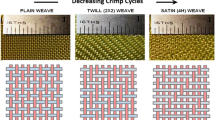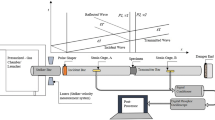Abstract
Aramid, glass, and steel have been compared for their performance in composite forms in protective applications, which are not the most usual ones. After underlining the importance of cut protection, a rather extensive review of the art in the domain of cut performance reveals that a good basis has been established, still leaving space for the study of non-coated, less uniformly interlocked composite yarn assemblies in the form of knitted structures or woven ones. Slightly departing from the traditionally friction-driven cut mechanism, those structures are distinguishable. This offers some elements for the long-awaited clarification of normalized test differences. Statistically, relevant families of commercial or semi-commercial products have been selected to address simultaneously the variability and the performance boundaries of those materials using instrumented ASTM cut equipment to obtain a “smarter” response of the material performance during its testing and to perform a “more sophisticated” data analysis beyond usually specified ones. The attempts to analyze more localized physical events open the door to micro or nanoanalysis of the fracture mechanism during the cut event which may differ from the traditional friction analysis. The contribution of meltable companion fillers, although not being the core of the study, could be translated to applications where those fillers become functional elements further improving the performance and synergism of the three basic elements, aramid, glass and steel. Previous study on the tribological properties of Kevlar® (DuPont’s registered trademark) composite fabrics stands as a natural prolongation of this study when applied to the knitted composite structures of this study.










Similar content being viewed by others
References
Dias JJ, Garcia-Elias M (2006) Injury 37(11):1071
Sorock GS, Lombardi DA, Courtney TK, Cotnam JP, Mittleman MA (2001) Saf Sci 38(3):241
Cheng YH (1997) Soc Sci Med 45(5):739
Gustafsson M, Ahlström G (2006) Int J Nurs Stud 43(5):557
Tejani N, Blocker R, Schiffelbein P, Rivet E (1997) In: Stull JO, Schwope AD (eds) Performance of protective clothing: sixth volume, ASTM STP 1273. American Society for Testing and Materials, p 84
Lara J, Turcot D, Daigle R, Boutin J (1996) In: Johnson JS, Mansdorf SZ (eds) Performance of protective clothing: fifth volume, ASTM STP 1237. American Society for Testing and Materials, p 23
Massé S, Lara J, Sirard C, Daigle R (1997) In: Stull JO, Schwope AD (eds) Performance of protective clothing: sixth volume, ASTM STP 1273. American Society for Testing and Materials, pp 66–83
Yarborough P, Schiffelbein P (2005) In: Yarborough P, Nelson CN (eds) Performance of protective clothing, Revisions to ASTM F 1790. p 134 (ISBN 0 8031 3488 6)
Lake J-G, Yeoh HO (1978) Int J Fract 14(5):509
Gent NA, Wang C (1996) J Polym Sci B 34:2231
Rebouillat S, Steffenino B (2005) In: Yarborough P, Nelson CN (eds) Performance of protective clothing. p 139 (ISBN 0 8031 3488 6)
Rebouillat S, Steffenino B (2006) In: Brebbia CA (ed) High performance structures and materials, vol III. WIT Press, p 279 (ISBN 1 84564 162 0)
Cho K, Lee D (1997) J Polym Sci B 36:1283
Thi VNB, Khanh VT, Lara J (2005) J Thermoplastic Compos Mater 18:23
Thi VNB, Khanh VT, Lara J (2009) Theor Appl Fract Mech 52(1):7
ISO13997, ISO/TC 94/SC 13/WG 5N 173, Protective clothing–mechanical properties–determination of resistance to cutting by sharp objects
Thi VNB, Khanh VT, Lara J (2005) In: Yarborough P, Nelson CN (eds) Performance of protective clothing. p 160 (ISBN 0 8031 3488 6)
Rebouillat S, Aramids (2001) In: Hearle JWS (ed) High performance fibres. Woodhead Publishing Limited, Abington, Cambridge, p 23 (ISBN 1 85573 539 3)
Lara J, Turcot D, Daigle R, Payot F (1996) In: Johnson JS, Mansdorf SZ (eds) Performance of protective clothing: fifth volume, ASTM STP 1237. American Society for Testing and Materials, p 32
ASTM F1790-97, Standard test method for measuring cut resistance of materials used in protective clothing
BS EN388 (2003) Protective gloves against mechanical risks
Rebouillat S, Steffenino B, Miret-Casas A US patent US2004011087
Rebouillat S, Moore SD, Steffenino B, WO/2008/045492, Cut-resistant yarns and method of manufacture
Nguyen TT, Khanh VT, Lara J (2005) In: Yarborough P, Nelson CN (eds) Performance of protective clothing. p 175 (ISBN 0 8031 3488 6)
Rebouillat S (1998) J Mater Sci 33(13):3293. doi:10.1023/A:1013225027778
Lara J, Massé S Evaluating the cutting resistance of protective clothing materials IRSST, p 145
Van Dingenen JLJ (2001) In: Hearle JWS (ed) High performance fibres. Woodhead Publishing Limited, p 62 (ISBN 1 85573 539 3)
American National Standard for Hand Protection Selection Criteria ANSI/ISEA 105-2000
Acknowledgements
Special thanks are due to Prof. Knit D. D. (A.M.C.-DP-Geneva-CH), recognized worldwide as knitting expert, for his dedicated assistance in the measurements, and for his great advice regarding the knitting pattern selection and the associated expertise. Gratitude is expressed to Dr. Masahiro Koma-san (Industrial Gloves/WakaTouch Malaysia SDN BHD) for his tremendous glove expertise, and support for the sample preparation on Shima-Seiki machinery. His dedication, hands-on approach, and human orientation have been duly appreciated.
Author information
Authors and Affiliations
Corresponding author
Rights and permissions
About this article
Cite this article
Rebouillat, S., Steffenino, B. & Miret-Casas, A. Aramid, steel, and glass: characterization via cut performance testing, of composite knitted fabrics and their constituent yarns, with a review of the art. J Mater Sci 45, 5378–5392 (2010). https://doi.org/10.1007/s10853-010-4590-5
Received:
Accepted:
Published:
Issue Date:
DOI: https://doi.org/10.1007/s10853-010-4590-5




